NATO's Role in Afghan Security
VerifiedAdded on 2020/05/16
|11
|2479
|33
AI Summary
This assignment explores NATO's significant role in ensuring Afghanistan's security. It examines the implementation of programs like ISAF and Resolute Support, focusing on their impact in strengthening Afghan security forces. The document also discusses the international support provided by NATO allies and partners to sustain these efforts until 2020. Finally, it highlights the growing areas of cooperation and political dialogue between NATO and Afghanistan.
Contribute Materials
Your contribution can guide someone’s learning journey. Share your
documents today.
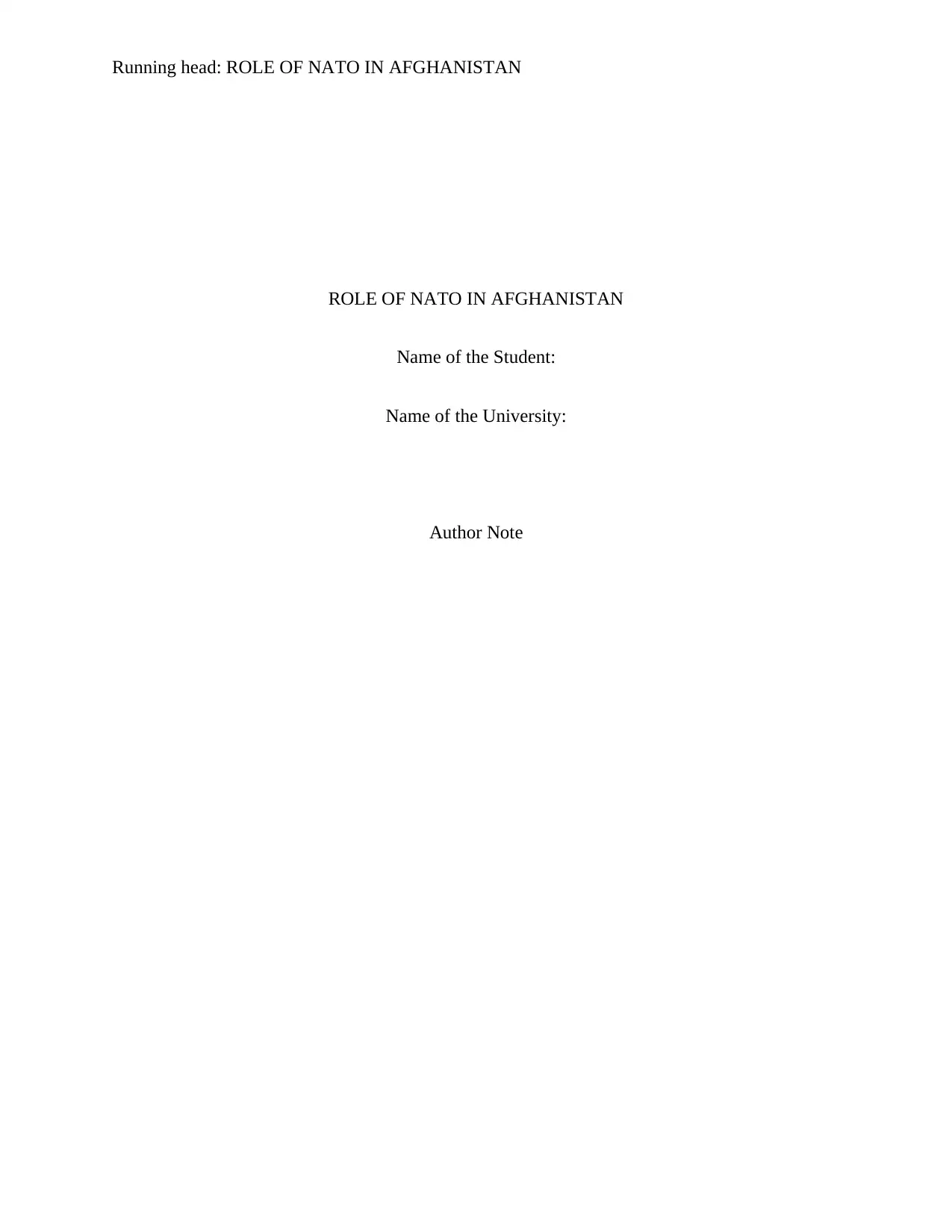
Running head: ROLE OF NATO IN AFGHANISTAN
ROLE OF NATO IN AFGHANISTAN
Name of the Student:
Name of the University:
Author Note
ROLE OF NATO IN AFGHANISTAN
Name of the Student:
Name of the University:
Author Note
Secure Best Marks with AI Grader
Need help grading? Try our AI Grader for instant feedback on your assignments.
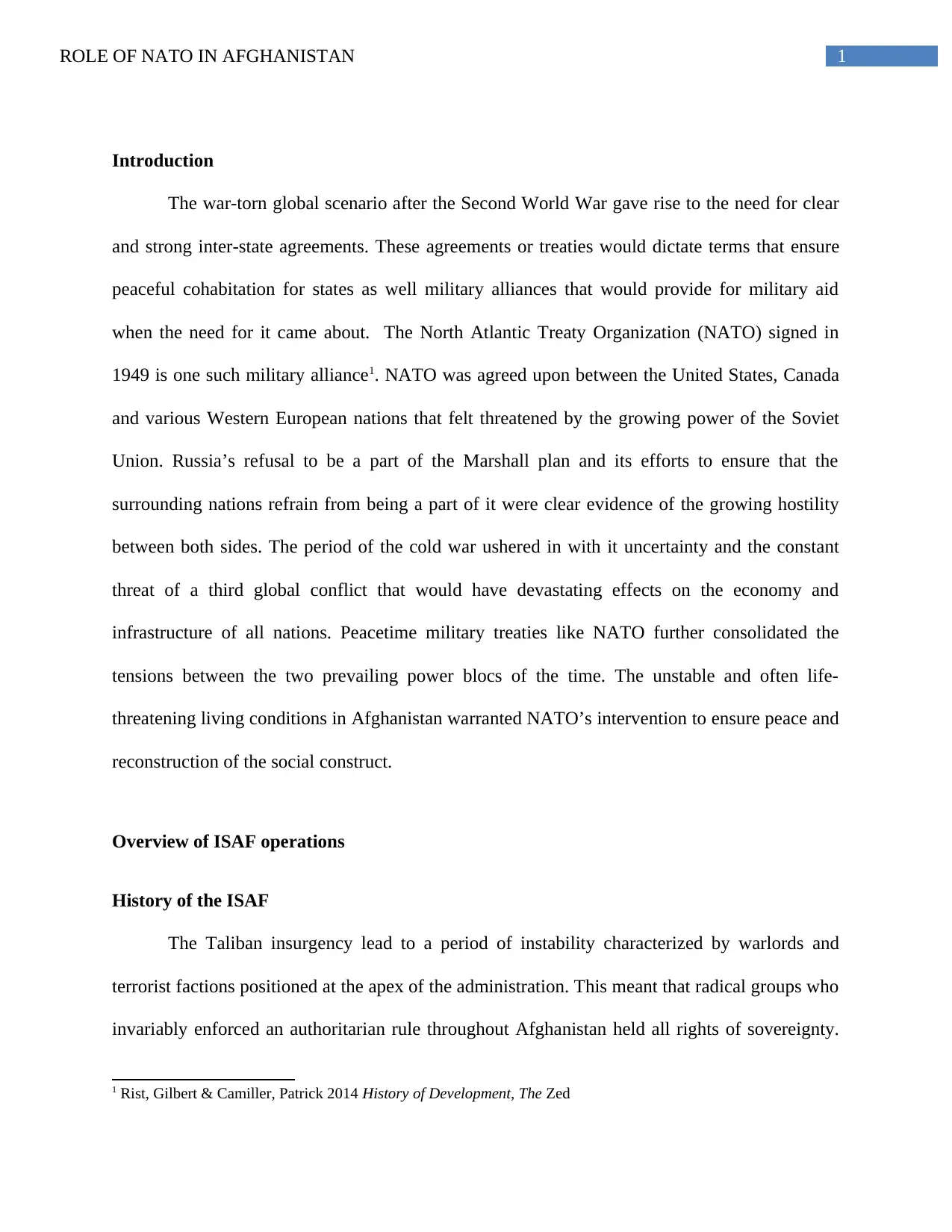
1ROLE OF NATO IN AFGHANISTAN
Introduction
The war-torn global scenario after the Second World War gave rise to the need for clear
and strong inter-state agreements. These agreements or treaties would dictate terms that ensure
peaceful cohabitation for states as well military alliances that would provide for military aid
when the need for it came about. The North Atlantic Treaty Organization (NATO) signed in
1949 is one such military alliance1. NATO was agreed upon between the United States, Canada
and various Western European nations that felt threatened by the growing power of the Soviet
Union. Russia’s refusal to be a part of the Marshall plan and its efforts to ensure that the
surrounding nations refrain from being a part of it were clear evidence of the growing hostility
between both sides. The period of the cold war ushered in with it uncertainty and the constant
threat of a third global conflict that would have devastating effects on the economy and
infrastructure of all nations. Peacetime military treaties like NATO further consolidated the
tensions between the two prevailing power blocs of the time. The unstable and often life-
threatening living conditions in Afghanistan warranted NATO’s intervention to ensure peace and
reconstruction of the social construct.
Overview of ISAF operations
History of the ISAF
The Taliban insurgency lead to a period of instability characterized by warlords and
terrorist factions positioned at the apex of the administration. This meant that radical groups who
invariably enforced an authoritarian rule throughout Afghanistan held all rights of sovereignty.
1 Rist, Gilbert & Camiller, Patrick 2014 History of Development, The Zed
Introduction
The war-torn global scenario after the Second World War gave rise to the need for clear
and strong inter-state agreements. These agreements or treaties would dictate terms that ensure
peaceful cohabitation for states as well military alliances that would provide for military aid
when the need for it came about. The North Atlantic Treaty Organization (NATO) signed in
1949 is one such military alliance1. NATO was agreed upon between the United States, Canada
and various Western European nations that felt threatened by the growing power of the Soviet
Union. Russia’s refusal to be a part of the Marshall plan and its efforts to ensure that the
surrounding nations refrain from being a part of it were clear evidence of the growing hostility
between both sides. The period of the cold war ushered in with it uncertainty and the constant
threat of a third global conflict that would have devastating effects on the economy and
infrastructure of all nations. Peacetime military treaties like NATO further consolidated the
tensions between the two prevailing power blocs of the time. The unstable and often life-
threatening living conditions in Afghanistan warranted NATO’s intervention to ensure peace and
reconstruction of the social construct.
Overview of ISAF operations
History of the ISAF
The Taliban insurgency lead to a period of instability characterized by warlords and
terrorist factions positioned at the apex of the administration. This meant that radical groups who
invariably enforced an authoritarian rule throughout Afghanistan held all rights of sovereignty.
1 Rist, Gilbert & Camiller, Patrick 2014 History of Development, The Zed
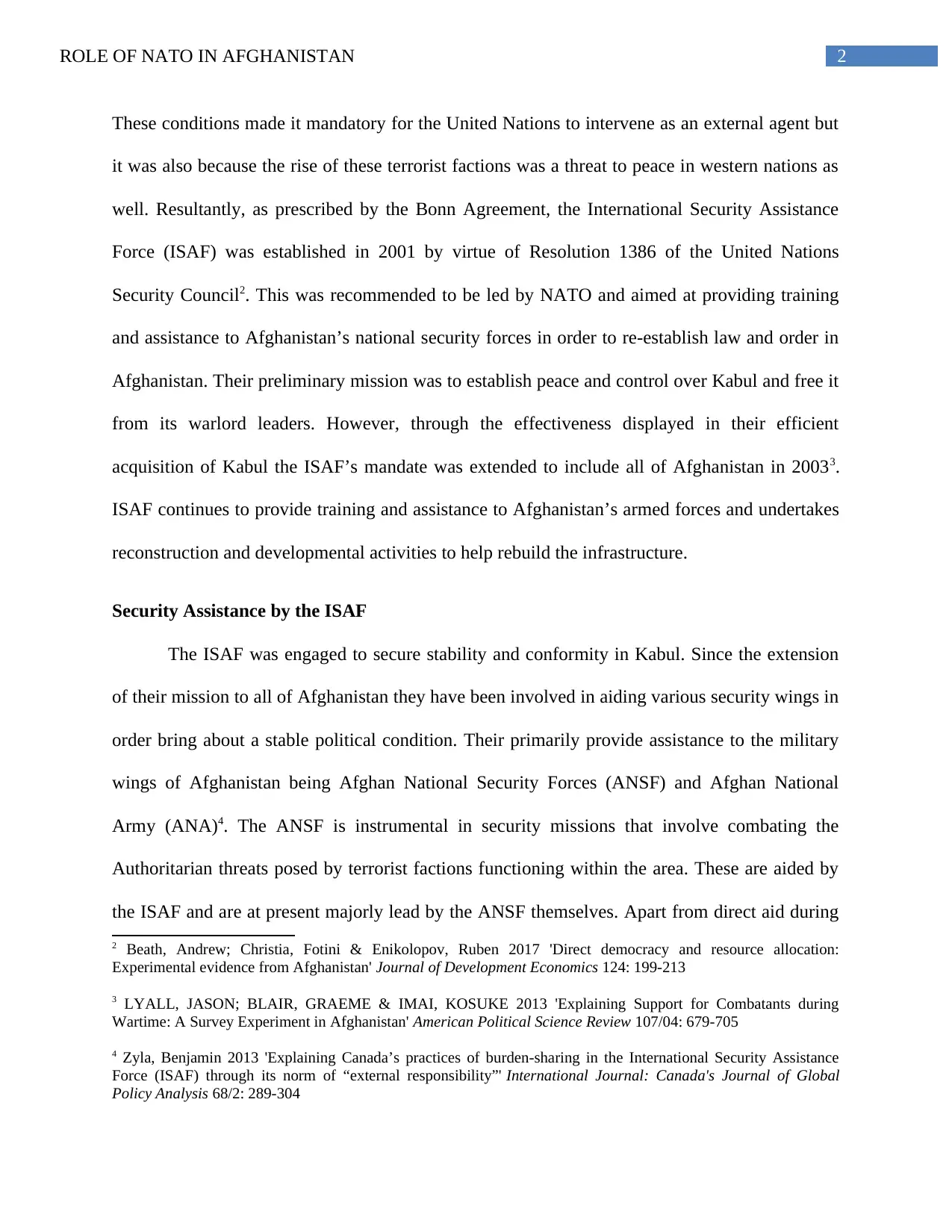
2ROLE OF NATO IN AFGHANISTAN
These conditions made it mandatory for the United Nations to intervene as an external agent but
it was also because the rise of these terrorist factions was a threat to peace in western nations as
well. Resultantly, as prescribed by the Bonn Agreement, the International Security Assistance
Force (ISAF) was established in 2001 by virtue of Resolution 1386 of the United Nations
Security Council2. This was recommended to be led by NATO and aimed at providing training
and assistance to Afghanistan’s national security forces in order to re-establish law and order in
Afghanistan. Their preliminary mission was to establish peace and control over Kabul and free it
from its warlord leaders. However, through the effectiveness displayed in their efficient
acquisition of Kabul the ISAF’s mandate was extended to include all of Afghanistan in 20033.
ISAF continues to provide training and assistance to Afghanistan’s armed forces and undertakes
reconstruction and developmental activities to help rebuild the infrastructure.
Security Assistance by the ISAF
The ISAF was engaged to secure stability and conformity in Kabul. Since the extension
of their mission to all of Afghanistan they have been involved in aiding various security wings in
order bring about a stable political condition. Their primarily provide assistance to the military
wings of Afghanistan being Afghan National Security Forces (ANSF) and Afghan National
Army (ANA)4. The ANSF is instrumental in security missions that involve combating the
Authoritarian threats posed by terrorist factions functioning within the area. These are aided by
the ISAF and are at present majorly lead by the ANSF themselves. Apart from direct aid during
2 Beath, Andrew; Christia, Fotini & Enikolopov, Ruben 2017 'Direct democracy and resource allocation:
Experimental evidence from Afghanistan' Journal of Development Economics 124: 199-213
3 LYALL, JASON; BLAIR, GRAEME & IMAI, KOSUKE 2013 'Explaining Support for Combatants during
Wartime: A Survey Experiment in Afghanistan' American Political Science Review 107/04: 679-705
4 Zyla, Benjamin 2013 'Explaining Canada’s practices of burden-sharing in the International Security Assistance
Force (ISAF) through its norm of “external responsibility”' International Journal: Canada's Journal of Global
Policy Analysis 68/2: 289-304
These conditions made it mandatory for the United Nations to intervene as an external agent but
it was also because the rise of these terrorist factions was a threat to peace in western nations as
well. Resultantly, as prescribed by the Bonn Agreement, the International Security Assistance
Force (ISAF) was established in 2001 by virtue of Resolution 1386 of the United Nations
Security Council2. This was recommended to be led by NATO and aimed at providing training
and assistance to Afghanistan’s national security forces in order to re-establish law and order in
Afghanistan. Their preliminary mission was to establish peace and control over Kabul and free it
from its warlord leaders. However, through the effectiveness displayed in their efficient
acquisition of Kabul the ISAF’s mandate was extended to include all of Afghanistan in 20033.
ISAF continues to provide training and assistance to Afghanistan’s armed forces and undertakes
reconstruction and developmental activities to help rebuild the infrastructure.
Security Assistance by the ISAF
The ISAF was engaged to secure stability and conformity in Kabul. Since the extension
of their mission to all of Afghanistan they have been involved in aiding various security wings in
order bring about a stable political condition. Their primarily provide assistance to the military
wings of Afghanistan being Afghan National Security Forces (ANSF) and Afghan National
Army (ANA)4. The ANSF is instrumental in security missions that involve combating the
Authoritarian threats posed by terrorist factions functioning within the area. These are aided by
the ISAF and are at present majorly lead by the ANSF themselves. Apart from direct aid during
2 Beath, Andrew; Christia, Fotini & Enikolopov, Ruben 2017 'Direct democracy and resource allocation:
Experimental evidence from Afghanistan' Journal of Development Economics 124: 199-213
3 LYALL, JASON; BLAIR, GRAEME & IMAI, KOSUKE 2013 'Explaining Support for Combatants during
Wartime: A Survey Experiment in Afghanistan' American Political Science Review 107/04: 679-705
4 Zyla, Benjamin 2013 'Explaining Canada’s practices of burden-sharing in the International Security Assistance
Force (ISAF) through its norm of “external responsibility”' International Journal: Canada's Journal of Global
Policy Analysis 68/2: 289-304
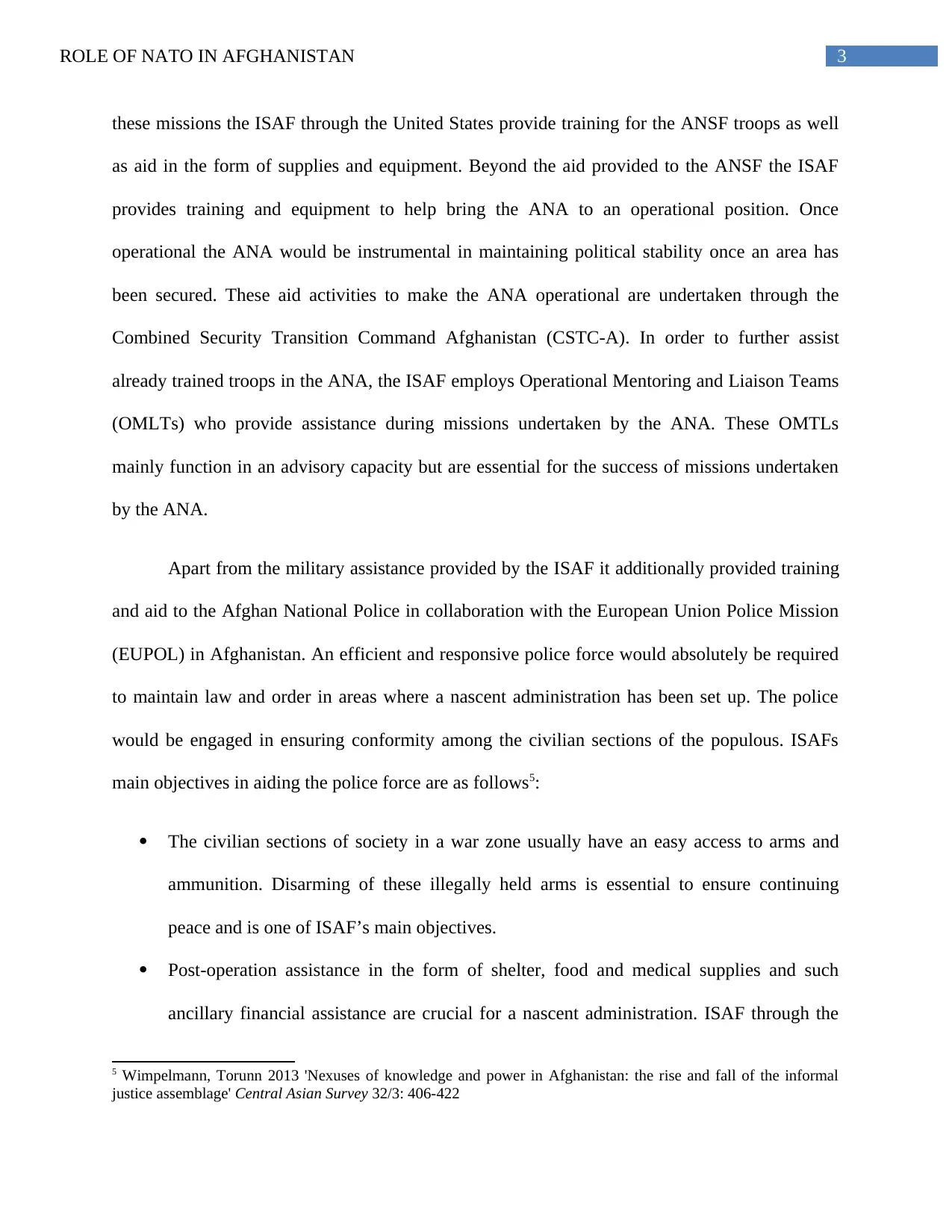
3ROLE OF NATO IN AFGHANISTAN
these missions the ISAF through the United States provide training for the ANSF troops as well
as aid in the form of supplies and equipment. Beyond the aid provided to the ANSF the ISAF
provides training and equipment to help bring the ANA to an operational position. Once
operational the ANA would be instrumental in maintaining political stability once an area has
been secured. These aid activities to make the ANA operational are undertaken through the
Combined Security Transition Command Afghanistan (CSTC-A). In order to further assist
already trained troops in the ANA, the ISAF employs Operational Mentoring and Liaison Teams
(OMLTs) who provide assistance during missions undertaken by the ANA. These OMTLs
mainly function in an advisory capacity but are essential for the success of missions undertaken
by the ANA.
Apart from the military assistance provided by the ISAF it additionally provided training
and aid to the Afghan National Police in collaboration with the European Union Police Mission
(EUPOL) in Afghanistan. An efficient and responsive police force would absolutely be required
to maintain law and order in areas where a nascent administration has been set up. The police
would be engaged in ensuring conformity among the civilian sections of the populous. ISAFs
main objectives in aiding the police force are as follows5:
The civilian sections of society in a war zone usually have an easy access to arms and
ammunition. Disarming of these illegally held arms is essential to ensure continuing
peace and is one of ISAF’s main objectives.
Post-operation assistance in the form of shelter, food and medical supplies and such
ancillary financial assistance are crucial for a nascent administration. ISAF through the
5 Wimpelmann, Torunn 2013 'Nexuses of knowledge and power in Afghanistan: the rise and fall of the informal
justice assemblage' Central Asian Survey 32/3: 406-422
these missions the ISAF through the United States provide training for the ANSF troops as well
as aid in the form of supplies and equipment. Beyond the aid provided to the ANSF the ISAF
provides training and equipment to help bring the ANA to an operational position. Once
operational the ANA would be instrumental in maintaining political stability once an area has
been secured. These aid activities to make the ANA operational are undertaken through the
Combined Security Transition Command Afghanistan (CSTC-A). In order to further assist
already trained troops in the ANA, the ISAF employs Operational Mentoring and Liaison Teams
(OMLTs) who provide assistance during missions undertaken by the ANA. These OMTLs
mainly function in an advisory capacity but are essential for the success of missions undertaken
by the ANA.
Apart from the military assistance provided by the ISAF it additionally provided training
and aid to the Afghan National Police in collaboration with the European Union Police Mission
(EUPOL) in Afghanistan. An efficient and responsive police force would absolutely be required
to maintain law and order in areas where a nascent administration has been set up. The police
would be engaged in ensuring conformity among the civilian sections of the populous. ISAFs
main objectives in aiding the police force are as follows5:
The civilian sections of society in a war zone usually have an easy access to arms and
ammunition. Disarming of these illegally held arms is essential to ensure continuing
peace and is one of ISAF’s main objectives.
Post-operation assistance in the form of shelter, food and medical supplies and such
ancillary financial assistance are crucial for a nascent administration. ISAF through the
5 Wimpelmann, Torunn 2013 'Nexuses of knowledge and power in Afghanistan: the rise and fall of the informal
justice assemblage' Central Asian Survey 32/3: 406-422
Secure Best Marks with AI Grader
Need help grading? Try our AI Grader for instant feedback on your assignments.
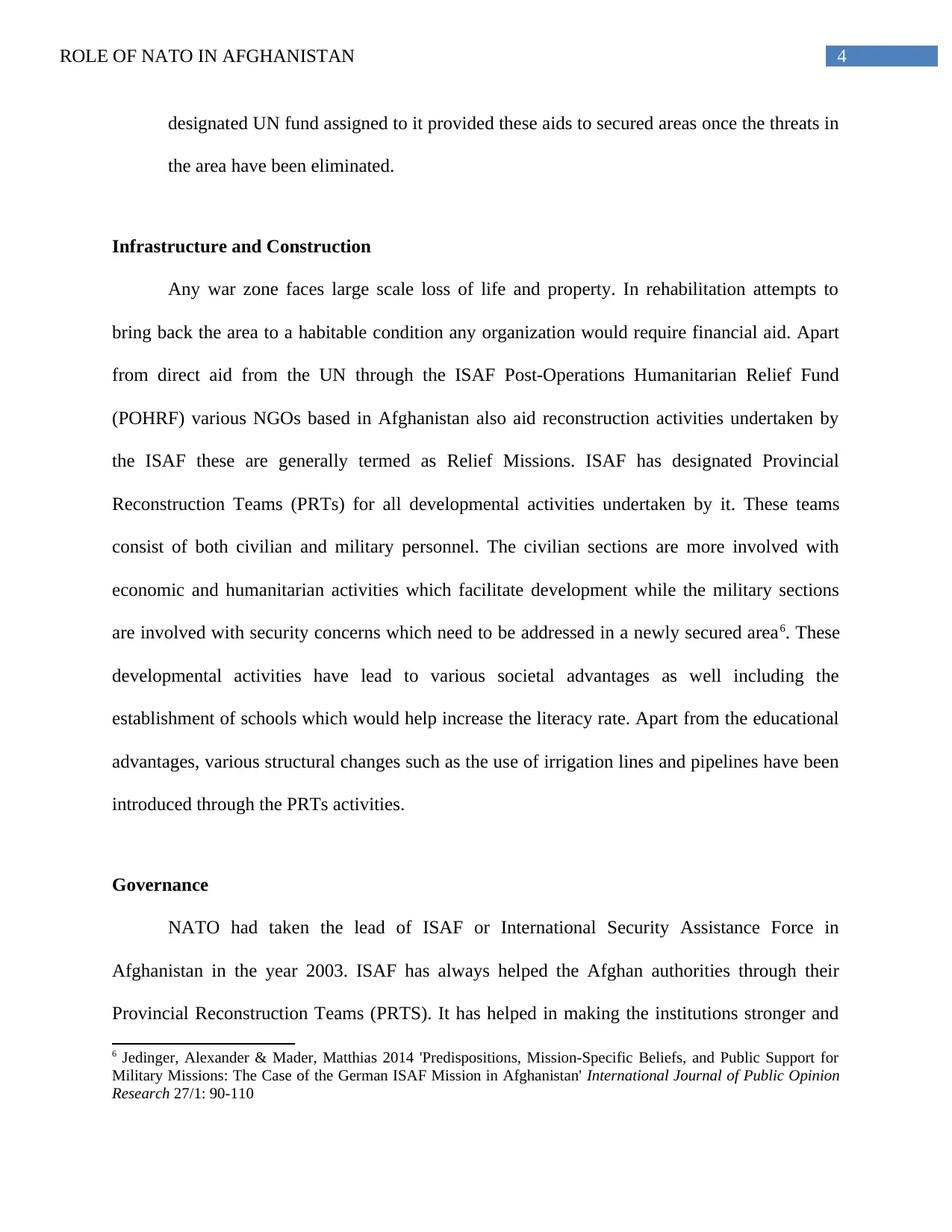
4ROLE OF NATO IN AFGHANISTAN
designated UN fund assigned to it provided these aids to secured areas once the threats in
the area have been eliminated.
Infrastructure and Construction
Any war zone faces large scale loss of life and property. In rehabilitation attempts to
bring back the area to a habitable condition any organization would require financial aid. Apart
from direct aid from the UN through the ISAF Post-Operations Humanitarian Relief Fund
(POHRF) various NGOs based in Afghanistan also aid reconstruction activities undertaken by
the ISAF these are generally termed as Relief Missions. ISAF has designated Provincial
Reconstruction Teams (PRTs) for all developmental activities undertaken by it. These teams
consist of both civilian and military personnel. The civilian sections are more involved with
economic and humanitarian activities which facilitate development while the military sections
are involved with security concerns which need to be addressed in a newly secured area6. These
developmental activities have lead to various societal advantages as well including the
establishment of schools which would help increase the literacy rate. Apart from the educational
advantages, various structural changes such as the use of irrigation lines and pipelines have been
introduced through the PRTs activities.
Governance
NATO had taken the lead of ISAF or International Security Assistance Force in
Afghanistan in the year 2003. ISAF has always helped the Afghan authorities through their
Provincial Reconstruction Teams (PRTS). It has helped in making the institutions stronger and
6 Jedinger, Alexander & Mader, Matthias 2014 'Predispositions, Mission-Specific Beliefs, and Public Support for
Military Missions: The Case of the German ISAF Mission in Afghanistan' International Journal of Public Opinion
Research 27/1: 90-110
designated UN fund assigned to it provided these aids to secured areas once the threats in
the area have been eliminated.
Infrastructure and Construction
Any war zone faces large scale loss of life and property. In rehabilitation attempts to
bring back the area to a habitable condition any organization would require financial aid. Apart
from direct aid from the UN through the ISAF Post-Operations Humanitarian Relief Fund
(POHRF) various NGOs based in Afghanistan also aid reconstruction activities undertaken by
the ISAF these are generally termed as Relief Missions. ISAF has designated Provincial
Reconstruction Teams (PRTs) for all developmental activities undertaken by it. These teams
consist of both civilian and military personnel. The civilian sections are more involved with
economic and humanitarian activities which facilitate development while the military sections
are involved with security concerns which need to be addressed in a newly secured area6. These
developmental activities have lead to various societal advantages as well including the
establishment of schools which would help increase the literacy rate. Apart from the educational
advantages, various structural changes such as the use of irrigation lines and pipelines have been
introduced through the PRTs activities.
Governance
NATO had taken the lead of ISAF or International Security Assistance Force in
Afghanistan in the year 2003. ISAF has always helped the Afghan authorities through their
Provincial Reconstruction Teams (PRTS). It has helped in making the institutions stronger and
6 Jedinger, Alexander & Mader, Matthias 2014 'Predispositions, Mission-Specific Beliefs, and Public Support for
Military Missions: The Case of the German ISAF Mission in Afghanistan' International Journal of Public Opinion
Research 27/1: 90-110
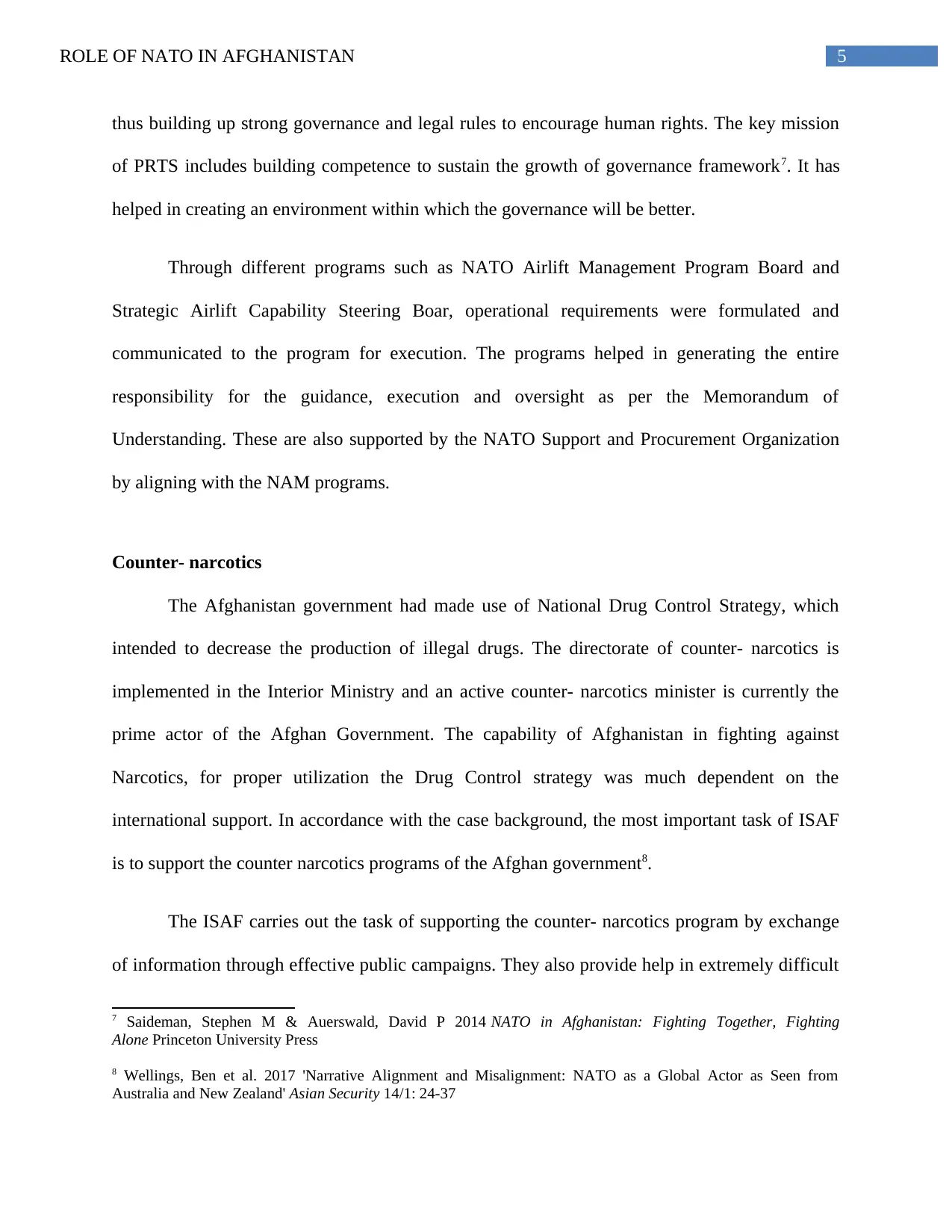
5ROLE OF NATO IN AFGHANISTAN
thus building up strong governance and legal rules to encourage human rights. The key mission
of PRTS includes building competence to sustain the growth of governance framework7. It has
helped in creating an environment within which the governance will be better.
Through different programs such as NATO Airlift Management Program Board and
Strategic Airlift Capability Steering Boar, operational requirements were formulated and
communicated to the program for execution. The programs helped in generating the entire
responsibility for the guidance, execution and oversight as per the Memorandum of
Understanding. These are also supported by the NATO Support and Procurement Organization
by aligning with the NAM programs.
Counter- narcotics
The Afghanistan government had made use of National Drug Control Strategy, which
intended to decrease the production of illegal drugs. The directorate of counter- narcotics is
implemented in the Interior Ministry and an active counter- narcotics minister is currently the
prime actor of the Afghan Government. The capability of Afghanistan in fighting against
Narcotics, for proper utilization the Drug Control strategy was much dependent on the
international support. In accordance with the case background, the most important task of ISAF
is to support the counter narcotics programs of the Afghan government8.
The ISAF carries out the task of supporting the counter- narcotics program by exchange
of information through effective public campaigns. They also provide help in extremely difficult
7 Saideman, Stephen M & Auerswald, David P 2014 NATO in Afghanistan: Fighting Together, Fighting
Alone Princeton University Press
8 Wellings, Ben et al. 2017 'Narrative Alignment and Misalignment: NATO as a Global Actor as Seen from
Australia and New Zealand' Asian Security 14/1: 24-37
thus building up strong governance and legal rules to encourage human rights. The key mission
of PRTS includes building competence to sustain the growth of governance framework7. It has
helped in creating an environment within which the governance will be better.
Through different programs such as NATO Airlift Management Program Board and
Strategic Airlift Capability Steering Boar, operational requirements were formulated and
communicated to the program for execution. The programs helped in generating the entire
responsibility for the guidance, execution and oversight as per the Memorandum of
Understanding. These are also supported by the NATO Support and Procurement Organization
by aligning with the NAM programs.
Counter- narcotics
The Afghanistan government had made use of National Drug Control Strategy, which
intended to decrease the production of illegal drugs. The directorate of counter- narcotics is
implemented in the Interior Ministry and an active counter- narcotics minister is currently the
prime actor of the Afghan Government. The capability of Afghanistan in fighting against
Narcotics, for proper utilization the Drug Control strategy was much dependent on the
international support. In accordance with the case background, the most important task of ISAF
is to support the counter narcotics programs of the Afghan government8.
The ISAF carries out the task of supporting the counter- narcotics program by exchange
of information through effective public campaigns. They also provide help in extremely difficult
7 Saideman, Stephen M & Auerswald, David P 2014 NATO in Afghanistan: Fighting Together, Fighting
Alone Princeton University Press
8 Wellings, Ben et al. 2017 'Narrative Alignment and Misalignment: NATO as a Global Actor as Seen from
Australia and New Zealand' Asian Security 14/1: 24-37
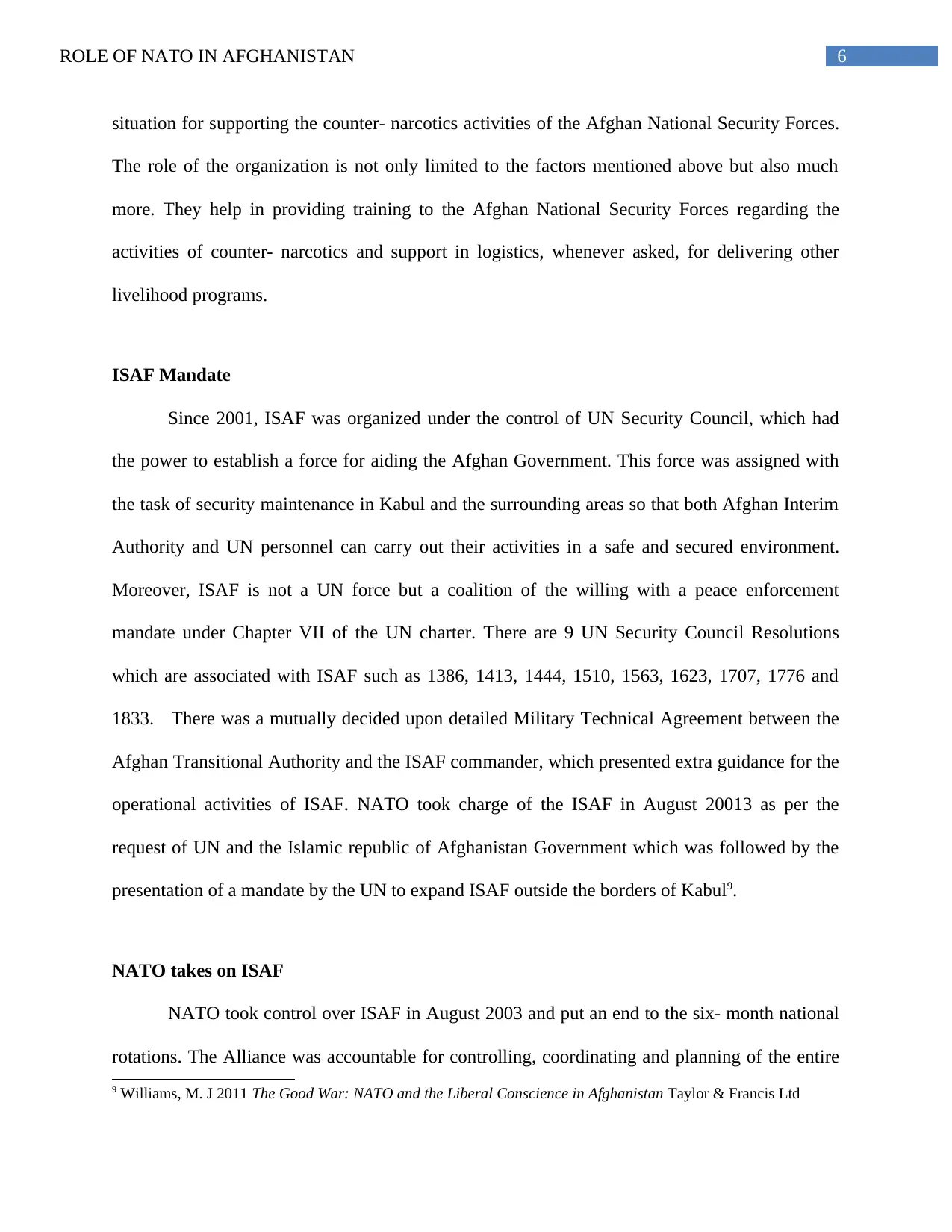
6ROLE OF NATO IN AFGHANISTAN
situation for supporting the counter- narcotics activities of the Afghan National Security Forces.
The role of the organization is not only limited to the factors mentioned above but also much
more. They help in providing training to the Afghan National Security Forces regarding the
activities of counter- narcotics and support in logistics, whenever asked, for delivering other
livelihood programs.
ISAF Mandate
Since 2001, ISAF was organized under the control of UN Security Council, which had
the power to establish a force for aiding the Afghan Government. This force was assigned with
the task of security maintenance in Kabul and the surrounding areas so that both Afghan Interim
Authority and UN personnel can carry out their activities in a safe and secured environment.
Moreover, ISAF is not a UN force but a coalition of the willing with a peace enforcement
mandate under Chapter VII of the UN charter. There are 9 UN Security Council Resolutions
which are associated with ISAF such as 1386, 1413, 1444, 1510, 1563, 1623, 1707, 1776 and
1833. There was a mutually decided upon detailed Military Technical Agreement between the
Afghan Transitional Authority and the ISAF commander, which presented extra guidance for the
operational activities of ISAF. NATO took charge of the ISAF in August 20013 as per the
request of UN and the Islamic republic of Afghanistan Government which was followed by the
presentation of a mandate by the UN to expand ISAF outside the borders of Kabul9.
NATO takes on ISAF
NATO took control over ISAF in August 2003 and put an end to the six- month national
rotations. The Alliance was accountable for controlling, coordinating and planning of the entire
9 Williams, M. J 2011 The Good War: NATO and the Liberal Conscience in Afghanistan Taylor & Francis Ltd
situation for supporting the counter- narcotics activities of the Afghan National Security Forces.
The role of the organization is not only limited to the factors mentioned above but also much
more. They help in providing training to the Afghan National Security Forces regarding the
activities of counter- narcotics and support in logistics, whenever asked, for delivering other
livelihood programs.
ISAF Mandate
Since 2001, ISAF was organized under the control of UN Security Council, which had
the power to establish a force for aiding the Afghan Government. This force was assigned with
the task of security maintenance in Kabul and the surrounding areas so that both Afghan Interim
Authority and UN personnel can carry out their activities in a safe and secured environment.
Moreover, ISAF is not a UN force but a coalition of the willing with a peace enforcement
mandate under Chapter VII of the UN charter. There are 9 UN Security Council Resolutions
which are associated with ISAF such as 1386, 1413, 1444, 1510, 1563, 1623, 1707, 1776 and
1833. There was a mutually decided upon detailed Military Technical Agreement between the
Afghan Transitional Authority and the ISAF commander, which presented extra guidance for the
operational activities of ISAF. NATO took charge of the ISAF in August 20013 as per the
request of UN and the Islamic republic of Afghanistan Government which was followed by the
presentation of a mandate by the UN to expand ISAF outside the borders of Kabul9.
NATO takes on ISAF
NATO took control over ISAF in August 2003 and put an end to the six- month national
rotations. The Alliance was accountable for controlling, coordinating and planning of the entire
9 Williams, M. J 2011 The Good War: NATO and the Liberal Conscience in Afghanistan Taylor & Francis Ltd
Paraphrase This Document
Need a fresh take? Get an instant paraphrase of this document with our AI Paraphraser
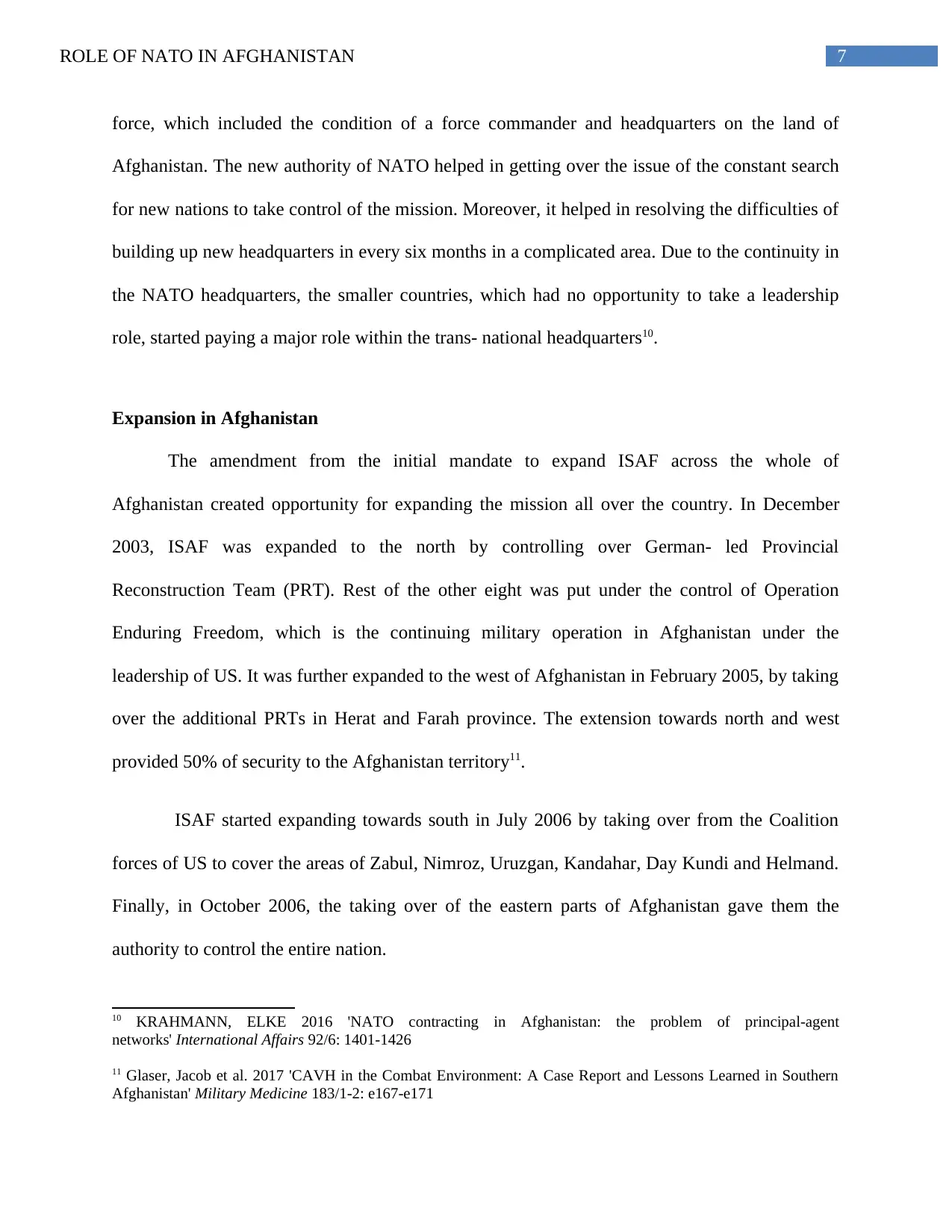
7ROLE OF NATO IN AFGHANISTAN
force, which included the condition of a force commander and headquarters on the land of
Afghanistan. The new authority of NATO helped in getting over the issue of the constant search
for new nations to take control of the mission. Moreover, it helped in resolving the difficulties of
building up new headquarters in every six months in a complicated area. Due to the continuity in
the NATO headquarters, the smaller countries, which had no opportunity to take a leadership
role, started paying a major role within the trans- national headquarters10.
Expansion in Afghanistan
The amendment from the initial mandate to expand ISAF across the whole of
Afghanistan created opportunity for expanding the mission all over the country. In December
2003, ISAF was expanded to the north by controlling over German- led Provincial
Reconstruction Team (PRT). Rest of the other eight was put under the control of Operation
Enduring Freedom, which is the continuing military operation in Afghanistan under the
leadership of US. It was further expanded to the west of Afghanistan in February 2005, by taking
over the additional PRTs in Herat and Farah province. The extension towards north and west
provided 50% of security to the Afghanistan territory11.
ISAF started expanding towards south in July 2006 by taking over from the Coalition
forces of US to cover the areas of Zabul, Nimroz, Uruzgan, Kandahar, Day Kundi and Helmand.
Finally, in October 2006, the taking over of the eastern parts of Afghanistan gave them the
authority to control the entire nation.
10 KRAHMANN, ELKE 2016 'NATO contracting in Afghanistan: the problem of principal-agent
networks' International Affairs 92/6: 1401-1426
11 Glaser, Jacob et al. 2017 'CAVH in the Combat Environment: A Case Report and Lessons Learned in Southern
Afghanistan' Military Medicine 183/1-2: e167-e171
force, which included the condition of a force commander and headquarters on the land of
Afghanistan. The new authority of NATO helped in getting over the issue of the constant search
for new nations to take control of the mission. Moreover, it helped in resolving the difficulties of
building up new headquarters in every six months in a complicated area. Due to the continuity in
the NATO headquarters, the smaller countries, which had no opportunity to take a leadership
role, started paying a major role within the trans- national headquarters10.
Expansion in Afghanistan
The amendment from the initial mandate to expand ISAF across the whole of
Afghanistan created opportunity for expanding the mission all over the country. In December
2003, ISAF was expanded to the north by controlling over German- led Provincial
Reconstruction Team (PRT). Rest of the other eight was put under the control of Operation
Enduring Freedom, which is the continuing military operation in Afghanistan under the
leadership of US. It was further expanded to the west of Afghanistan in February 2005, by taking
over the additional PRTs in Herat and Farah province. The extension towards north and west
provided 50% of security to the Afghanistan territory11.
ISAF started expanding towards south in July 2006 by taking over from the Coalition
forces of US to cover the areas of Zabul, Nimroz, Uruzgan, Kandahar, Day Kundi and Helmand.
Finally, in October 2006, the taking over of the eastern parts of Afghanistan gave them the
authority to control the entire nation.
10 KRAHMANN, ELKE 2016 'NATO contracting in Afghanistan: the problem of principal-agent
networks' International Affairs 92/6: 1401-1426
11 Glaser, Jacob et al. 2017 'CAVH in the Combat Environment: A Case Report and Lessons Learned in Southern
Afghanistan' Military Medicine 183/1-2: e167-e171
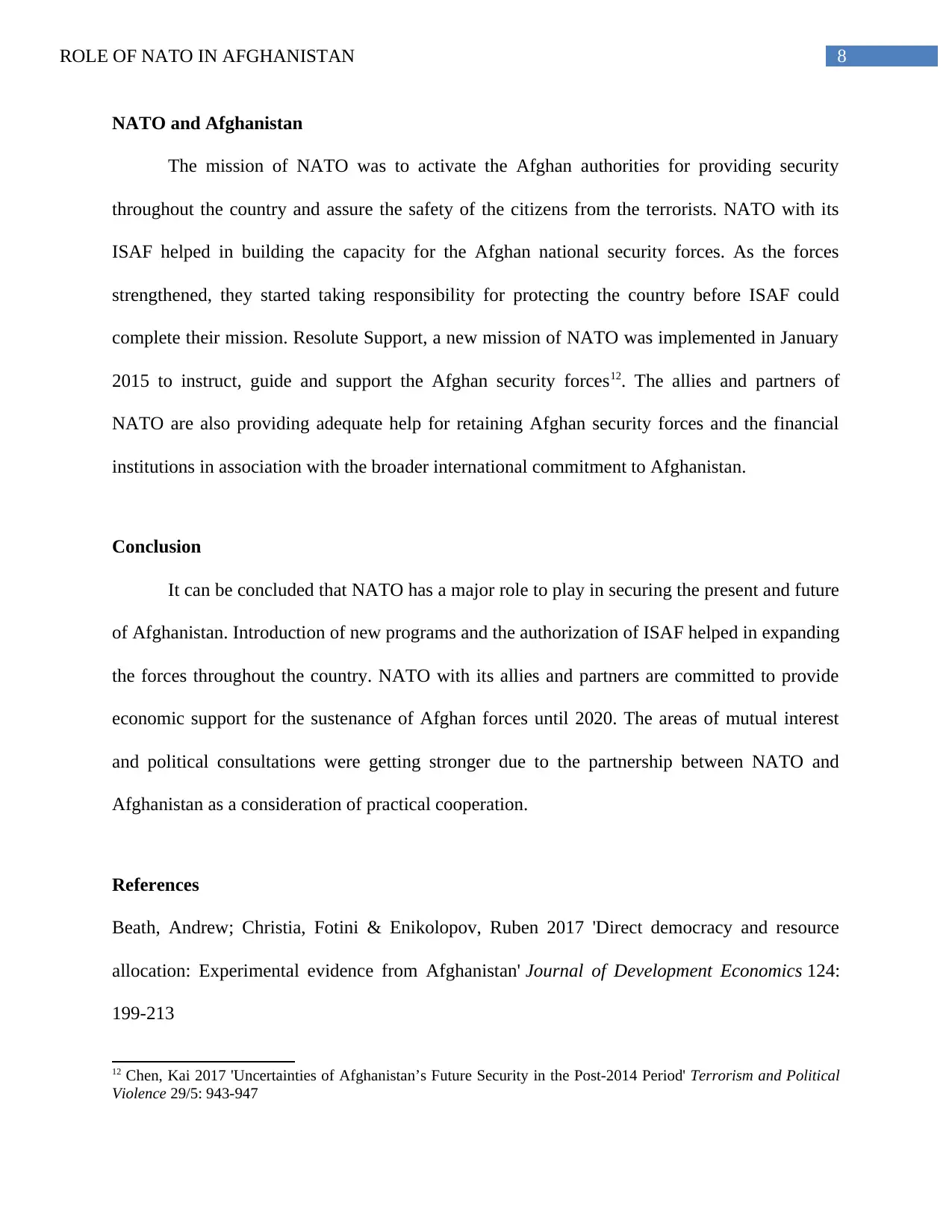
8ROLE OF NATO IN AFGHANISTAN
NATO and Afghanistan
The mission of NATO was to activate the Afghan authorities for providing security
throughout the country and assure the safety of the citizens from the terrorists. NATO with its
ISAF helped in building the capacity for the Afghan national security forces. As the forces
strengthened, they started taking responsibility for protecting the country before ISAF could
complete their mission. Resolute Support, a new mission of NATO was implemented in January
2015 to instruct, guide and support the Afghan security forces12. The allies and partners of
NATO are also providing adequate help for retaining Afghan security forces and the financial
institutions in association with the broader international commitment to Afghanistan.
Conclusion
It can be concluded that NATO has a major role to play in securing the present and future
of Afghanistan. Introduction of new programs and the authorization of ISAF helped in expanding
the forces throughout the country. NATO with its allies and partners are committed to provide
economic support for the sustenance of Afghan forces until 2020. The areas of mutual interest
and political consultations were getting stronger due to the partnership between NATO and
Afghanistan as a consideration of practical cooperation.
References
Beath, Andrew; Christia, Fotini & Enikolopov, Ruben 2017 'Direct democracy and resource
allocation: Experimental evidence from Afghanistan' Journal of Development Economics 124:
199-213
12 Chen, Kai 2017 'Uncertainties of Afghanistan’s Future Security in the Post-2014 Period' Terrorism and Political
Violence 29/5: 943-947
NATO and Afghanistan
The mission of NATO was to activate the Afghan authorities for providing security
throughout the country and assure the safety of the citizens from the terrorists. NATO with its
ISAF helped in building the capacity for the Afghan national security forces. As the forces
strengthened, they started taking responsibility for protecting the country before ISAF could
complete their mission. Resolute Support, a new mission of NATO was implemented in January
2015 to instruct, guide and support the Afghan security forces12. The allies and partners of
NATO are also providing adequate help for retaining Afghan security forces and the financial
institutions in association with the broader international commitment to Afghanistan.
Conclusion
It can be concluded that NATO has a major role to play in securing the present and future
of Afghanistan. Introduction of new programs and the authorization of ISAF helped in expanding
the forces throughout the country. NATO with its allies and partners are committed to provide
economic support for the sustenance of Afghan forces until 2020. The areas of mutual interest
and political consultations were getting stronger due to the partnership between NATO and
Afghanistan as a consideration of practical cooperation.
References
Beath, Andrew; Christia, Fotini & Enikolopov, Ruben 2017 'Direct democracy and resource
allocation: Experimental evidence from Afghanistan' Journal of Development Economics 124:
199-213
12 Chen, Kai 2017 'Uncertainties of Afghanistan’s Future Security in the Post-2014 Period' Terrorism and Political
Violence 29/5: 943-947
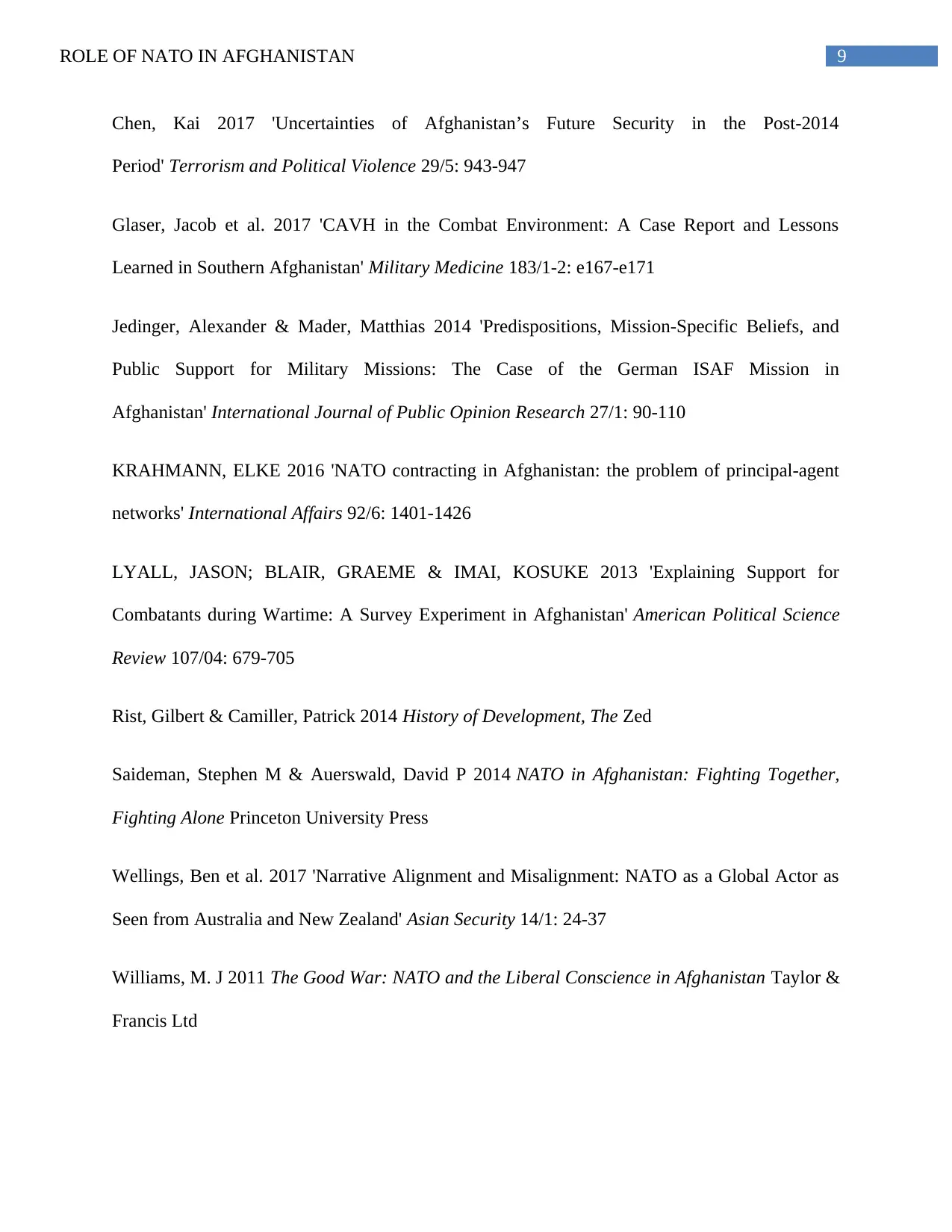
9ROLE OF NATO IN AFGHANISTAN
Chen, Kai 2017 'Uncertainties of Afghanistan’s Future Security in the Post-2014
Period' Terrorism and Political Violence 29/5: 943-947
Glaser, Jacob et al. 2017 'CAVH in the Combat Environment: A Case Report and Lessons
Learned in Southern Afghanistan' Military Medicine 183/1-2: e167-e171
Jedinger, Alexander & Mader, Matthias 2014 'Predispositions, Mission-Specific Beliefs, and
Public Support for Military Missions: The Case of the German ISAF Mission in
Afghanistan' International Journal of Public Opinion Research 27/1: 90-110
KRAHMANN, ELKE 2016 'NATO contracting in Afghanistan: the problem of principal-agent
networks' International Affairs 92/6: 1401-1426
LYALL, JASON; BLAIR, GRAEME & IMAI, KOSUKE 2013 'Explaining Support for
Combatants during Wartime: A Survey Experiment in Afghanistan' American Political Science
Review 107/04: 679-705
Rist, Gilbert & Camiller, Patrick 2014 History of Development, The Zed
Saideman, Stephen M & Auerswald, David P 2014 NATO in Afghanistan: Fighting Together,
Fighting Alone Princeton University Press
Wellings, Ben et al. 2017 'Narrative Alignment and Misalignment: NATO as a Global Actor as
Seen from Australia and New Zealand' Asian Security 14/1: 24-37
Williams, M. J 2011 The Good War: NATO and the Liberal Conscience in Afghanistan Taylor &
Francis Ltd
Chen, Kai 2017 'Uncertainties of Afghanistan’s Future Security in the Post-2014
Period' Terrorism and Political Violence 29/5: 943-947
Glaser, Jacob et al. 2017 'CAVH in the Combat Environment: A Case Report and Lessons
Learned in Southern Afghanistan' Military Medicine 183/1-2: e167-e171
Jedinger, Alexander & Mader, Matthias 2014 'Predispositions, Mission-Specific Beliefs, and
Public Support for Military Missions: The Case of the German ISAF Mission in
Afghanistan' International Journal of Public Opinion Research 27/1: 90-110
KRAHMANN, ELKE 2016 'NATO contracting in Afghanistan: the problem of principal-agent
networks' International Affairs 92/6: 1401-1426
LYALL, JASON; BLAIR, GRAEME & IMAI, KOSUKE 2013 'Explaining Support for
Combatants during Wartime: A Survey Experiment in Afghanistan' American Political Science
Review 107/04: 679-705
Rist, Gilbert & Camiller, Patrick 2014 History of Development, The Zed
Saideman, Stephen M & Auerswald, David P 2014 NATO in Afghanistan: Fighting Together,
Fighting Alone Princeton University Press
Wellings, Ben et al. 2017 'Narrative Alignment and Misalignment: NATO as a Global Actor as
Seen from Australia and New Zealand' Asian Security 14/1: 24-37
Williams, M. J 2011 The Good War: NATO and the Liberal Conscience in Afghanistan Taylor &
Francis Ltd
Secure Best Marks with AI Grader
Need help grading? Try our AI Grader for instant feedback on your assignments.

10ROLE OF NATO IN AFGHANISTAN
Wimpelmann, Torunn 2013 'Nexuses of knowledge and power in Afghanistan: the rise and fall
of the informal justice assemblage' Central Asian Survey 32/3: 406-422
Zyla, Benjamin 2013 'Explaining Canada’s practices of burden-sharing in the International
Security Assistance Force (ISAF) through its norm of “external responsibility”' International
Journal: Canada's Journal of Global Policy Analysis 68/2: 289-304
Wimpelmann, Torunn 2013 'Nexuses of knowledge and power in Afghanistan: the rise and fall
of the informal justice assemblage' Central Asian Survey 32/3: 406-422
Zyla, Benjamin 2013 'Explaining Canada’s practices of burden-sharing in the International
Security Assistance Force (ISAF) through its norm of “external responsibility”' International
Journal: Canada's Journal of Global Policy Analysis 68/2: 289-304
1 out of 11
Related Documents
Your All-in-One AI-Powered Toolkit for Academic Success.
+13062052269
info@desklib.com
Available 24*7 on WhatsApp / Email
![[object Object]](/_next/static/media/star-bottom.7253800d.svg)
Unlock your academic potential
© 2024 | Zucol Services PVT LTD | All rights reserved.
